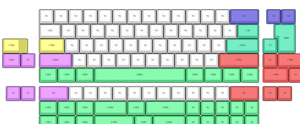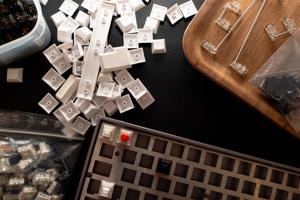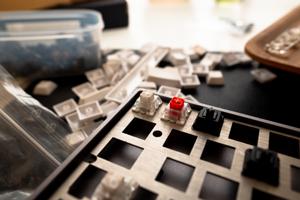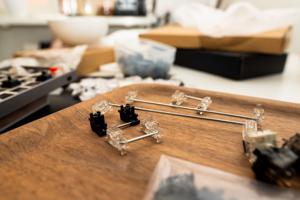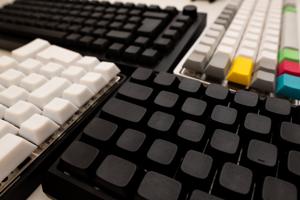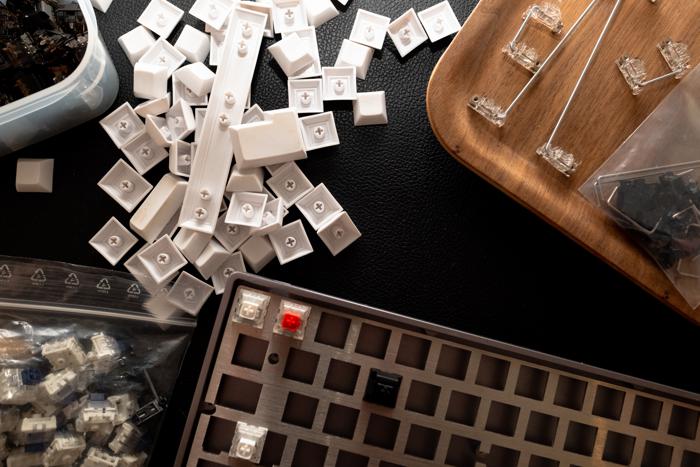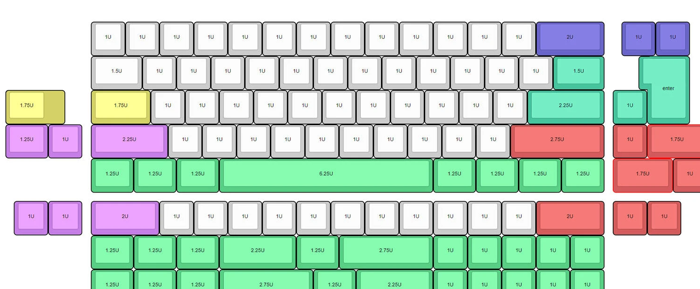Keyboard components and how they effect the end result
In this article I thought I would share an overview and my thoughts on many of the component considerations for building your own mechanical keyboard, and how I feel they influence the end result.
For some of the things listed here I will share my preference and why I prefer it, but it does not mean its best.
Key parameters for a good end result?
These are not universal and will of course depend on your preference, however there are some things that seems to be popular to strive for to get a good end result.
-
The weight and the density of the case matters for sound quite a bit.
-
Excess noise in form of scratchy switches or rattly key stabilizers is something that people tend to go to great lengths to get rid of.
-
Material and Profile matters both for sound and your accuracy with your typing style.
-
Combination of components makes it so that there are almost infinite outcomes in the end result of a keyboard build.
Formfactor
This is ofcourse not a component by itself, however it will impact the selection of components. I mean if your looking for a 75% (Tenkeyless) keyboard, then obviously you have to pick a PCB and case that is for that formfactor.
I would say that for custom mechanical keyboards, 60% and 65% formfactor is probably the most common followed by 75%.
My personal preference here is 60% (with dedicated arrow keys). I like the esthetics of this size of keyboard and find that the size of it in combination with my fairly big hands allow me to basically reach all sides of it very easily.. this is nice because I feel it gives me good references to touch-type (typing without looking).
Case
These come in various sizes to accommodate different form factors, but also in many different materials such as: aluminium, acrylic, abs
Your choice of case will impact the keyboard build end result a lot both in terms of look and feel of course but also in how much it will cost... and you may want to consider aspects like the things I am listing below.
Sound
The density and weight of your case will significantly impact the sounds signature of your keyboard. Basically by standing on a heavier less "hollow" base you will probably find that it sounds more premium and crisp (for lack of better words)
Design
There are many different designs and suttle trends when it comes to design of keyboard cases, things like: Colors, Typing angle, RGB diffusion etc.
Ergonomics
In my experience this is probably not on top of many peoples list of purchase criterias, however the keyboard case plays a big part in how ergonomical the keyboard will be.
Things like the typing angle and if the case has the option to raise or lower the angle to your preference.
Actually I would say that most custom keyboard cases does not have such options so its even more important that you pick one that works for you, most common angles are probably 5 percent or 7 percent.
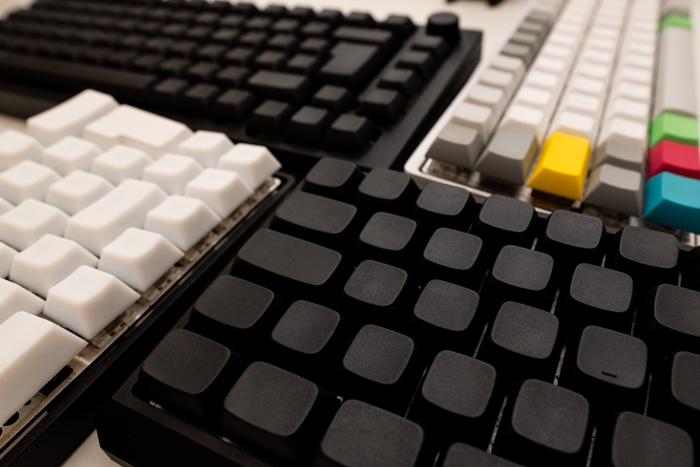
PCB
The Printed Circuit Board (PCB) is what you mount your switches to and it is what connects everything in the keyboard.
If you're new to them then they may look scary but most of the time as far as electronics go, they are actually pretty straight forward. There is a few things I would consider looking in to when picking a PCB.
Assembly
Nowadays most keyboard PCB's seem to come with basic components already soldered on to them (capacitors and such), and the trend is going toward "hotswap" sockets which will not require any soldering.
Typical assembly is that you will have to solder on the switches, 2x thru hole solder points per switch and many boards also have the possibility to mount upward facing LED's.
Compatibility
They follow the formfactor (like 40, 60, 75 % etc) but even within the formfactor there are variant or options on how you configure the layout, and by configuring I mean... how you actually place the switches on the board. Normally there are more holes in the board then what you will actually use, this is there so that you have the option to maybe run both ANSI or ISO layout, have two small spacebars maybe?
On the product page for the PCB there should be some illustration to show you what options you have for layout. This is how KBDFans usually draw theirs, but you find similar on other vendor pages.
The colored sections represent options you have for those rows of keys.
Plate
The plate rests above the PCB and is what you mount the switches in, these are often made of steel, aluminium, brass or acrylic and each with its own characteristics in terms of feel and esthetics.
Technically you can decide not to use a plate with your keyboard build and just mount the switches directly to the PCB. Personally I have never tried this and is a bit sceptical as to why you would want to do this, at least to my logic I would think this means you would not have such a stable platform to type on (ie less rigid and maybe more flex).
And in addition this would mean that your switches is seated lower than intended in the case which may look a bit strange.
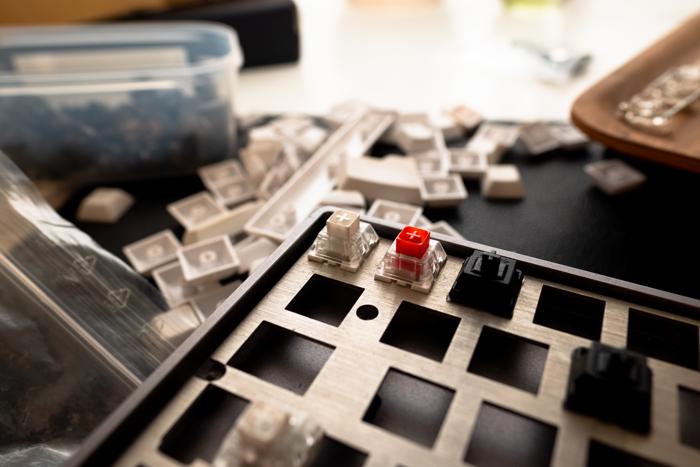
Switches
These are what is under each key and are responsible for register a keypress. There are so many options when it comes to switches, each with its own characteristics both in terms of sound and feel.
Your choice of switches will of course impact the end result but as for most things you pick for your keyboard, it is much a matter of taste. I will not go in depth on this but will give you some example of switch types below and how they may affect the end result.
If you are planning to spend a fair but of money on a custom keyboard, then I can definitely recommend that you pick some switches you are interested in and order one of each to test out.
Weight
Switches come in different weight, basically what this means is that the spring inside them have different tension, resulting in a different amount of force required to register and bottom out.
Your choice of weight for the switches matters quite a bit, its a balance. To heavy switches will likely cause fatigue in your fingers over a longer period of use, and to light will possibly feel like they register to easily.
Smoothness
Often times you will find that us keyboard nerds talk about how smooth a switch feel when pressed, for many a smooth feeling switch is the most desired and we and some manufacturers go to great length to achieve this.
Some parameters that effects the perceived "smoothness" of a switch:
-
Weight: A heavier switch may be perceived as smoother to some.
-
Lube: It is very common that people open the switch housing and apply lube to make the switch smoother, this is also lately done to some switches by the manufacturer.
-
Housing: The material of the housing ie the plastic used could potentially have an impact on the smoothness, honestly hard to judge i feel. But basically different plastics have different levels of friction which can be measured in a scientific way. (Ya this is a thing :-) )
Switch types
You can say that keyboard switches have three distinct types if you consider them from "user experience", this comes down to how they feel when registering a keypress and for bottom out.
For each switch type there are internal aspects that differentiate them also in how they achieve their function, I will focus more on feel here.
Clicky
These switches are designed to have an audible click as a form of tactile event when pressed. Personally I enjoy a good clicky switch with a good crisp click when you press them.
There are radical different ways that the click event is achieved, so I would advice to order sample before concluding on which one you want.
Tactile
The name of this type can be somewhat confusing I feel I mean aren't they all tactile?, However the tactile switch type refers to a switch that has a sort of bump as its main tactile event, this bump can be more or less noticeable.
In some cases these switches can be perceived as heavier than their actual spring weight, and some tactile switches may be perceived as clicky.
Linear
For these there are no tactile event and they are moving without obstruction from press > register keypress > bottom out, for me personally these are what I tend to pick the most for my everyday keyboards.
Depending on the weight and the materials used in a linear switch some may notice friction more in these type of switches, it is quite popular to improve this by opening the switch and adding a thin coat of lube.
Stabilizers
Updating...
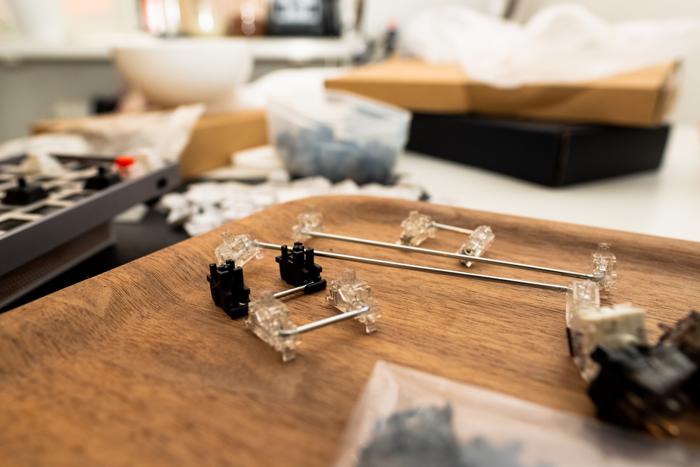
Keycaps
Updating...
